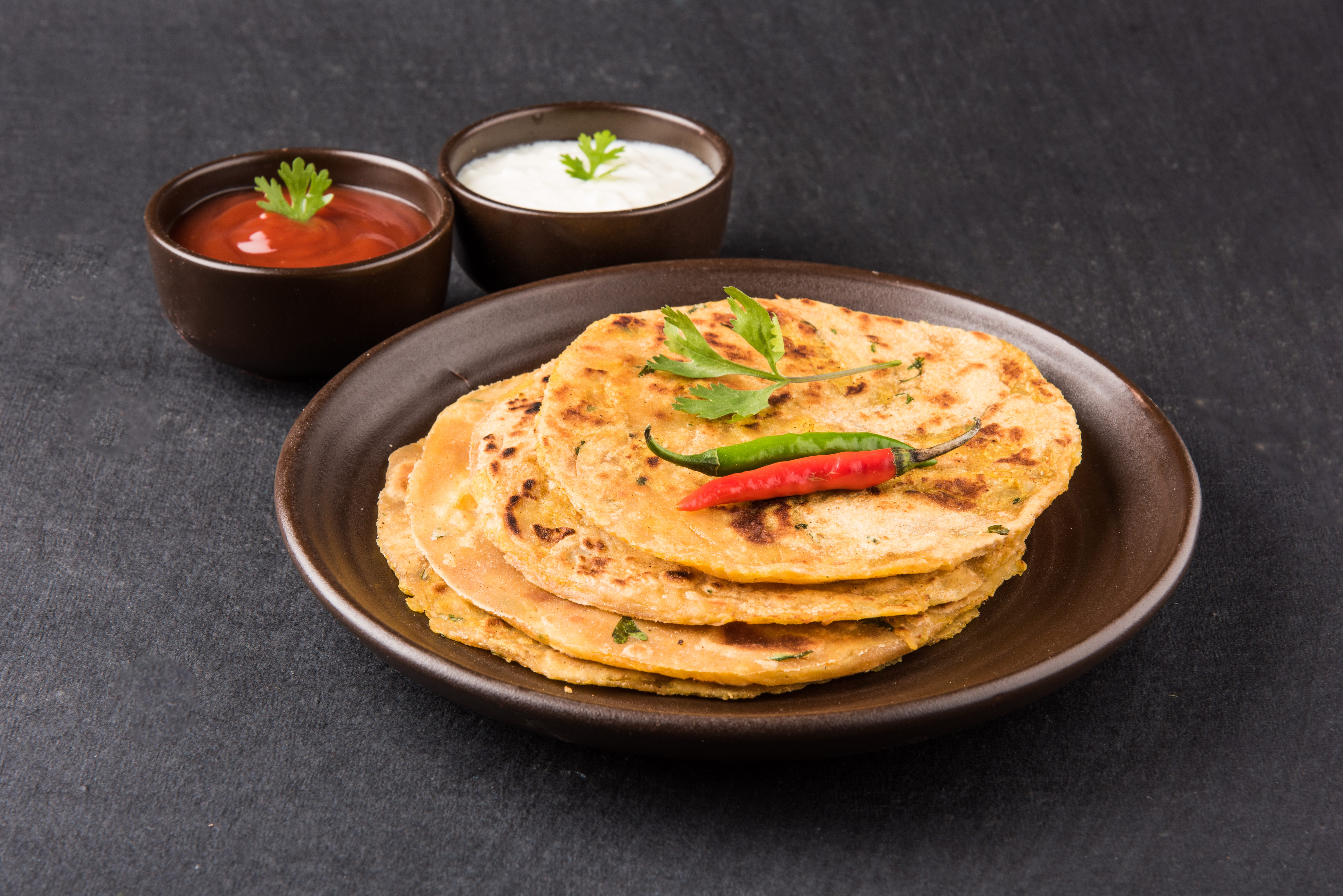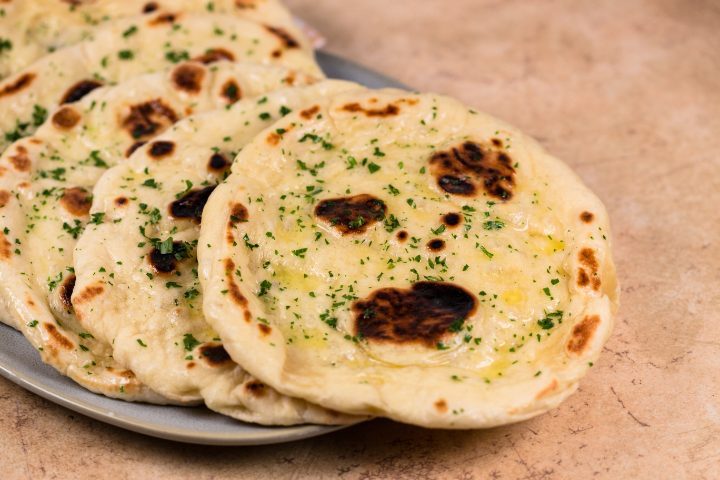
Chapati , also called chapatti, is known in America as Indian flatbreadbread, and is originally from Punjab and also widespread in some areas of East Africa, such as Kenya, Tanzania and Uganda. It is a sort of low, round flatbread, with a diameter of about 20-25cm, perfect for accompanying stews, dahl, chana masala and spicy dishes rich in sauces such as prawn curry, chicken tikka masala and many other dishes.
Making it is extremely easy: just sift the flours, arrange them in a fountain shape on a pastry board and pour in a little water at a time, kneading vigorously and adding salt only at the end. The soft dough obtained is left to rest for about twenty minutes under a cloth, then divided into many balls to be rolled out into thin discs.
At this point, all you have to do is cook them, 1 minute per side, on a very hot non-stick pan or, if you have one, on the traditional "tawa", a flat pan widely used in the Indian subcontinent, usually made of cast iron or aluminum. The result will be soft, elastic and fragrant flatbreads, perfect for collecting sauces and gravies, but also excellent stuffed with cheese, legume hummus, grilled vegetables and anything else you like.
What is Chapati Bread?
Chapati, also known as roti, is a traditional unleavened flatbread that has been a staple in Indian cuisine for centuries. Its origins trace back to ancient India, where it was a primary food source for rural communities due to its simplicity and nutritional value. Some historians believe chapati dates back over 5,000 years, with evidence suggesting its presence in the Indus Valley Civilization.
Made from whole wheat flour (atta), water, and sometimes a pinch of salt, chapatis are rolled into thin circles and cooked on a hot griddle (tava) until they develop golden brown spots. Unlike naan, which is made with yeast or other leavening agents, chapati remains soft and pliable, making it perfect for scooping up curries, dals, and vegetables. Over time, chapati has spread beyond India to other South Asian countries, East Africa, and even the Caribbean, where variations of the bread are enjoyed in different cultures.
Pro Tips for The Best Chapati Bread
- Knead the dough for at least 8–10 minutes until it becomes soft and smooth. This helps develop gluten, making the chapatis light and flexible. Let it rest for at least 30 minutes to enhance elasticity.
- The dough should be soft but not sticky. If it’s too dry, the chapatis will turn hard; if too wet, they’ll be difficult to roll. Add water gradually while kneading.
- To make your chapati puff up, flip it twice during cooking. The final flip should be onto direct flame or high heat to create steam inside, making it soft and airy.
- For extra softness and flavor, brush warm chapatis with ghee or butter immediately after cooking. This keeps them moist and prevents drying out.
What is The Difference Between Naan and Chapati?
Chapati is an unleavened flatbread made with whole wheat flour (atta) and water. It is rolled thin and cooked on a tava (griddle), making it soft and light. Naan, on the other hand, is a leavened bread made with all-purpose flour, yeast (or baking powder), and yogurt, giving it a thicker, fluffier, and slightly chewy texture. It is traditionally cooked in a tandoor (clay oven), which gives it a charred, smoky flavor.
Are Roti and Chapati The Same Type of Bread?
They can be used interchangeably, but there is a difference between them! Roti is a broader term that refers to any type of unleavened Indian flatbread, including chapati, tandoori roti, and phulka. Therefore, Chapati is a type of Roti!
What Does Chapati Bread Taste Like?
Chapati bread has a mild, nutty, and slightly earthy flavor due to the whole wheat flour (atta) used in its preparation. It has a soft and chewy texture when fresh, with a light crispiness on the surface from cooking on a hot griddle. Since chapati is neutral in taste, it pairs well with curries, vegetables, and dals, absorbing flavors beautifully. Adding ghee or butter enhances its richness and softness.
What Flours Should I Use for Chapati?
Traditional chapati is made with atta (whole wheat flour), which has a fine texture and high gluten content. If unavailable, use a mix of whole wheat and all-purpose flour for softness.
Is Chapati Bread Supposed to Be Hard or Soft?
Chapati is supposed to be soft and pliable, not hard. A well-made chapati should be light, slightly chewy, and flexible, making it easy to tear and scoop up food.
Why Did My Chapati Get So Hard and Tough?
If chapatis turn out hard, it’s usually due to overcooking, too little water in the dough, or not letting the dough rest properly. Brushing with ghee or butter after cooking helps keep them soft and moist.
Chapati Variations
There are several popular variations of chapati, each with unique flavors and textures:
- Phulka – A thin chapati that puffs up when cooked, often finished over an open flame.
- Tandoori Roti – A thicker, slightly crispy chapati cooked in a tandoor (clay oven).
- Paratha – A layered, flaky version of chapati, often made with ghee and sometimes stuffed.
- Missi Roti – Made with a mix of whole wheat and gram flour (besan), spiced for extra flavor.
- Roomali Roti – A very thin and soft chapati, stretched by hand and cooked on an inverted pan.
What is Chapati Used For?
Chapati bread is used as a staple accompaniment in Indian and South Asian cuisine. It is mainly used to scoop up curries, dals (lentils), vegetables, and meat dishes, acting as a natural utensil. Chapati can also be rolled into wraps with fillings like paneer, chicken, or vegetables for a quick meal. In some cultures, it is torn into pieces and mixed with yogurt or stews.
Can Chapati Bread Be Made Ahead of Time?
Yes, chapati can be made ahead of time! To keep them soft and fresh, store them in a covered container or wrap them in a cloth. You can also partially cook chapatis (lightly on both sides) and store them in an airtight container, then fully cook them when needed. If making in bulk, chapatis can be refrigerated for 2–3 days!
Can I Freeze Chapati Bread?
Yes! To freeze, stack fully cooked chapatis with parchment paper between each one and store them in an airtight bag or container. They can last for up to 2–3 months in the freezer. When ready to eat, reheat directly on a hot pan or in the microwave, and they’ll be soft and fresh again!
How to Store Chapati Bread
The chapati can be stored at room temperature, wrapped in a clean cloth, for a maximum of 4 days.
Ingredients
How to Make Chapati Bread (Step-By-Step)

Collect the all-purpose flour and the whole wheat flour in a bowl, then mix them with a spoon.
Collect the all-purpose flour and the whole wheat flour in a bowl, then mix them with a spoon.

Transfer them to a fine mesh strainer and sift them onto a work surface.
Transfer them to a fine mesh strainer and sift them onto a work surface.

Form a fountain, digging a cavity in the center.
Form a fountain, digging a cavity in the center.

Start pouring a little water at a time.
Start pouring a little water at a time.

Knead with your fingertips and, when the flour has absorbed all the water, work the mixture vigorously for a few minutes, then add 1 tablespoon of water on the surface of the dough and continue to work the mixture for 10 minutes, seasoning with 1/2 tsp of salt.
Knead with your fingertips and, when the flour has absorbed all the water, work the mixture vigorously for a few minutes, then add 1 tablespoon of water on the surface of the dough and continue to work the mixture for 10 minutes, seasoning with 1/2 tsp of salt.

Finally, form a homogeneous dough, cover it with a clean cloth and let it rest for 20 minutes: it will be easier to roll out.
Finally, form a homogeneous dough, cover it with a clean cloth and let it rest for 20 minutes: it will be easier to roll out.

Once the necessary time has passed, take portions of dough of 70 grams each and shape into balls.
Once the necessary time has passed, take portions of dough of 70 grams each and shape into balls.

Roll them out with a rolling pin until they form round buns, with a diameter of 20-25 cm, then remove the excess flour. At this point, put a large, low-sided pan on the stove and let it heat up well.
Roll them out with a rolling pin until they form round buns, with a diameter of 20-25 cm, then remove the excess flour. At this point, put a large, low-sided pan on the stove and let it heat up well.

When the pan is very hot, but not boiling, place the first disc of dough and cook it for 1 minute then, when bubbles start to form on the surface, turn it over to the other side.
When the pan is very hot, but not boiling, place the first disc of dough and cook it for 1 minute then, when bubbles start to form on the surface, turn it over to the other side.

Deflate the bubbles with a spatula, to help the bread cook without burning it and to allow the steam to circulate inside it. While cooking each chapati, keep the heat medium-low and make sure the pan is hot but not boiling.
Deflate the bubbles with a spatula, to help the bread cook without burning it and to allow the steam to circulate inside it. While cooking each chapati, keep the heat medium-low and make sure the pan is hot but not boiling.

As they are ready, transfer each chapati onto a tea towel and cover them with a cloth, so that they remain moist and soft.
As they are ready, transfer each chapati onto a tea towel and cover them with a cloth, so that they remain moist and soft.

The chapatis are ready to be served with your favorite Indian dishes. Enjoy!
The chapatis are ready to be served with your favorite Indian dishes. Enjoy!
;Resize,width=712;)
;Resize,width=712;)
;Resize,width=712;)
;Resize,width=767;)
